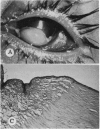Abstract
The high mortality rate among children with severe corneal xerophthalmia is well recognized. The present study investigates, for the first time, mortality among the very much larger number of otherwise healthy free-living children with mild xerophthalmia (night blindness and Bitot's spots). An average of 3481 children (under 6 years of age) living in six Indonesian villages were reexamined by an ophthalmologist, pediatrician, and nutritionist every 3 months for 18 months. The overall prevalence of mild xerophthalmia was 4.9%. During the 18 months of observation, 132 children died. Of these, 24 had mild xerophthalmia and 108 had normal eyes at the 3-monthly examination preceding their death. Mortality rates were calculated for each 3-month interval by classifying all children by their ocular status at the start of the interval, and then dividing the number of deaths within the interval by the number of children of the same ocular status followed up for that interval. Mortality rates for the six 3-month intervals were then added together, and the results expressed as deaths per 1000 "child-intervals" of follow-up. Overall mortality rates for children with mild xerophthalmia and for children with normal eyes were 23.3 and 5.3, respectively, a ratio of 4 to 1. Excess mortality among the mildly xerophthalmic children increased with the severity of their xerophthalmia. Mortality rates for children with night blindness, with Bitot's spots, and with the two conditions concurrently were 2.7, 6.6, and 8.6 times the mortality rate of non-xerophthalmic children. This direct, almost linear relation between mortality and the severity of mild xerophthalmia was still present after standardizing for age and for the presence or absence of respiratory infection and protein-energy malnutrition. In the population studied, 16% of all deaths in children 1 to 6 years of age were directly related to vitamin A deficiency identified by the presence of mild xerophthalmia. These results suggest: that the existence of mild vitamin A deficiency in a community justifies initiation of vigorous intervention measures to reduce mortality, as much as to prevent the rarer cases of blindness; that night blindness and Bitot's spots should be accorded the same respect as is low "weight for height" in identifying those children in urgent need of medical attention; that ocular criteria used for determining the existence and severity of a vitamin A problem be reevaluated; and that the ophthalmic community, which has long been responsible for managing xerophthalmia, must now re-alert nutritionists, pediatricians, and public health workers to the serious systemic consequences accompanying even mild
Full text
PDF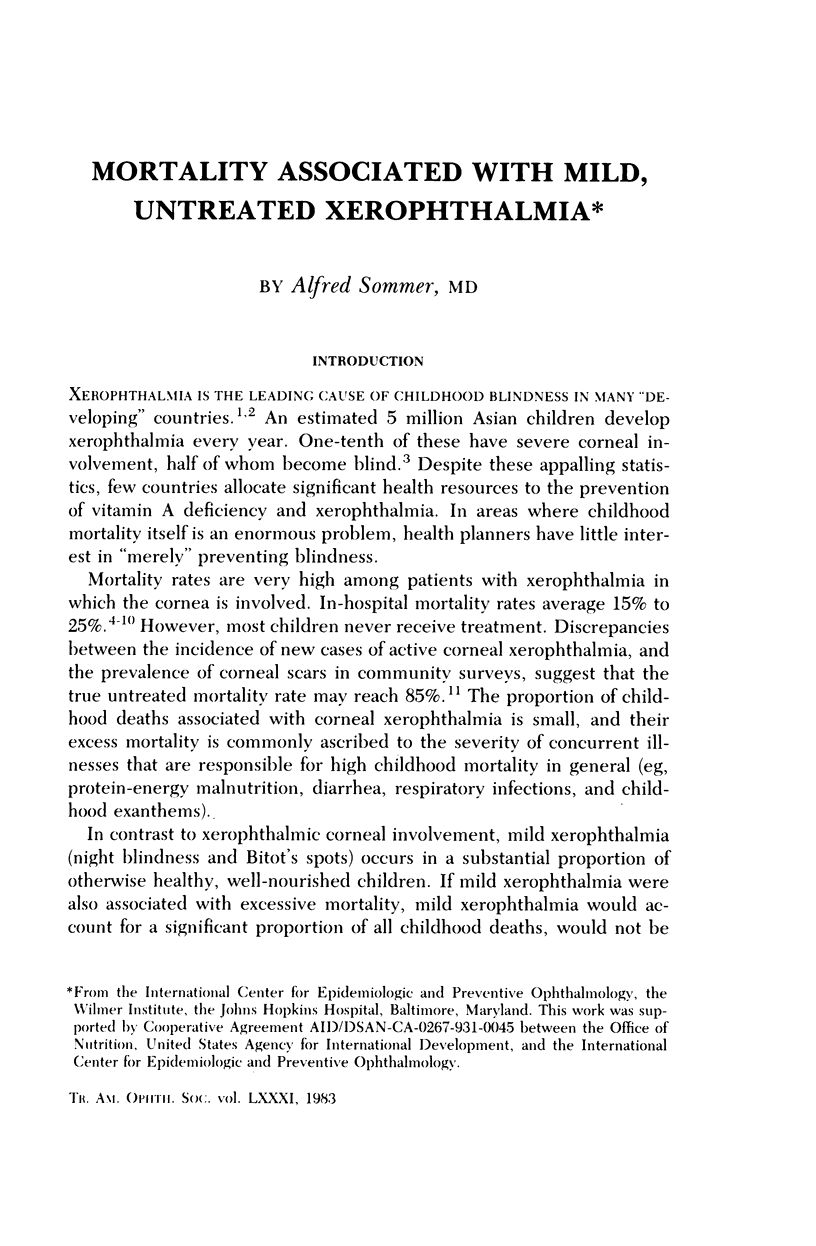
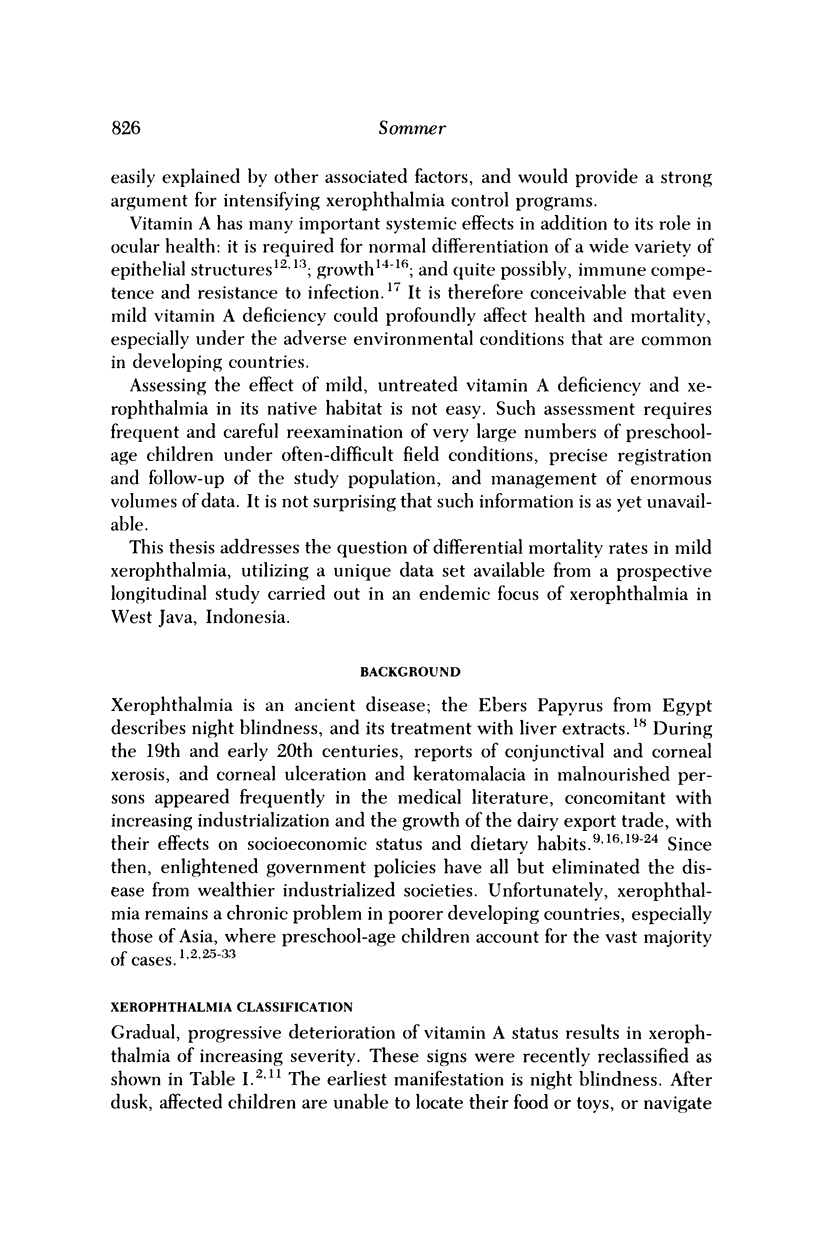

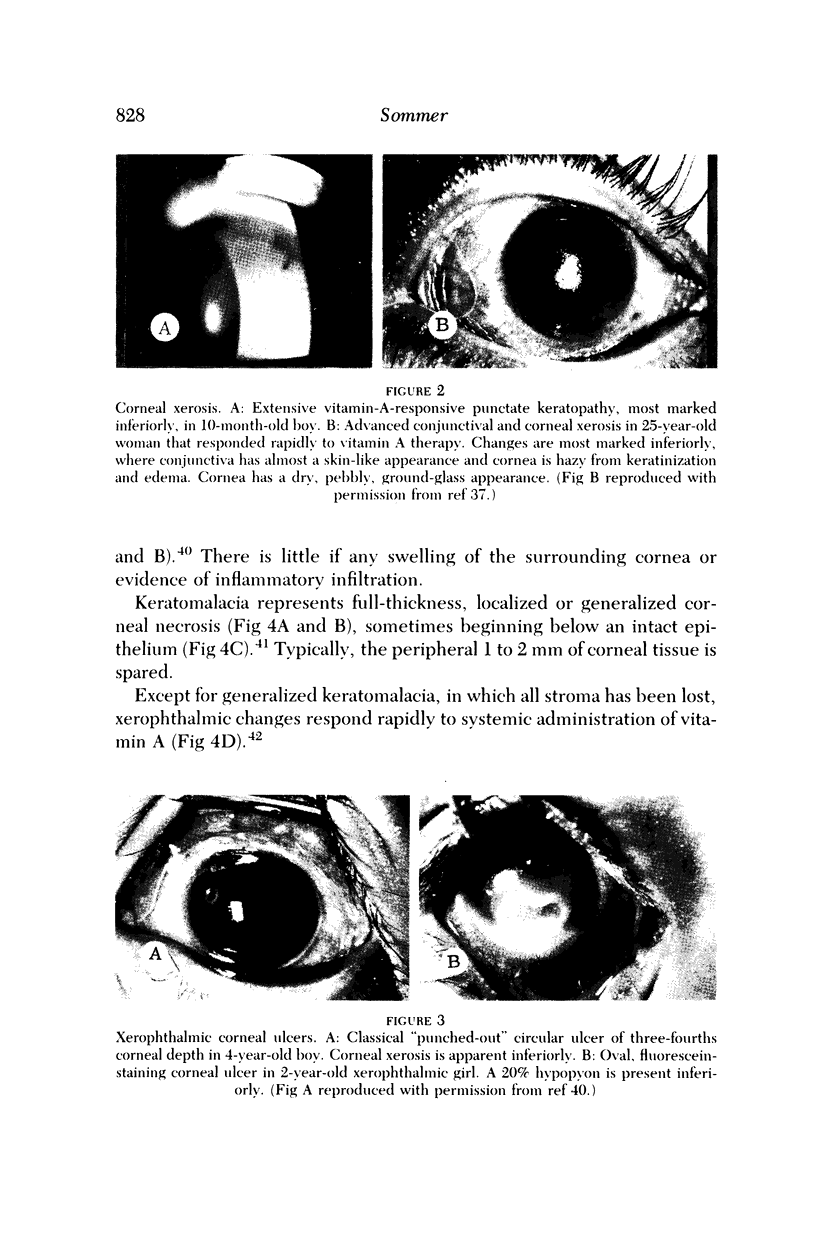
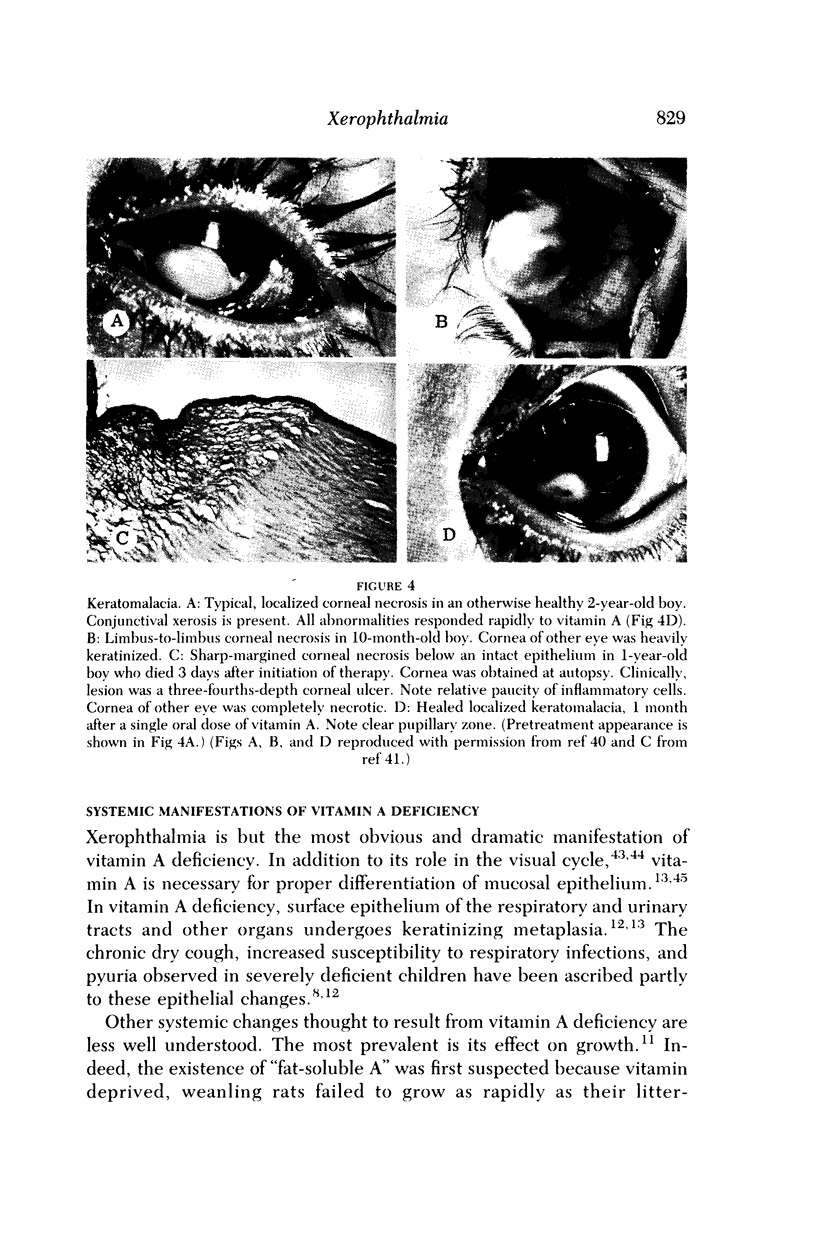
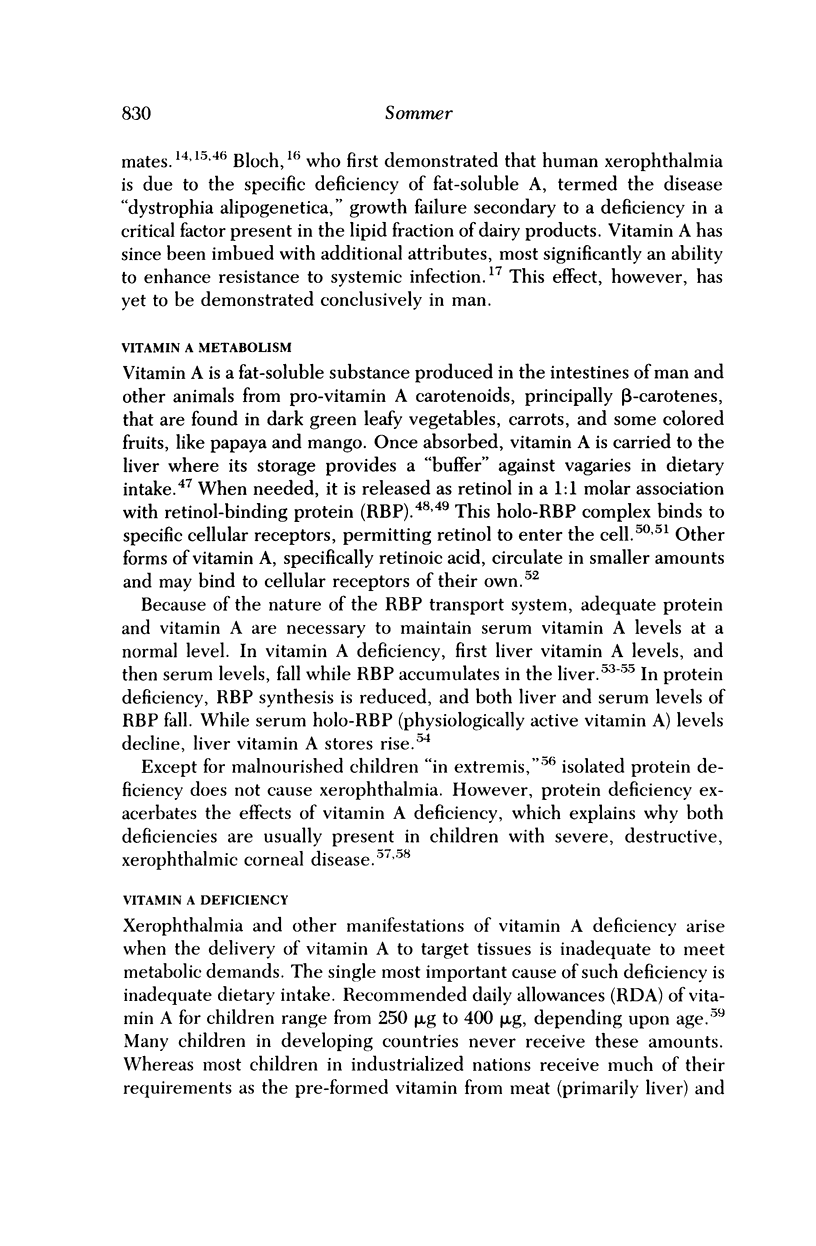
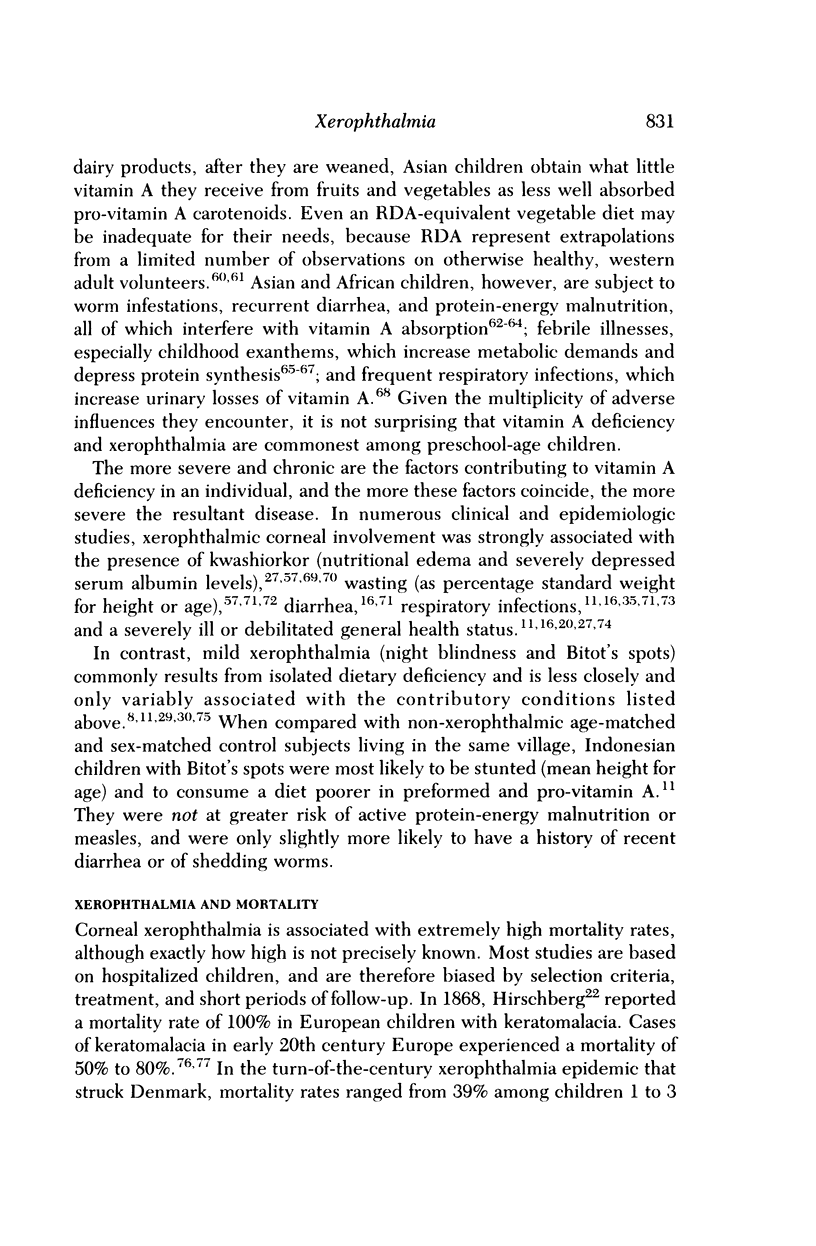
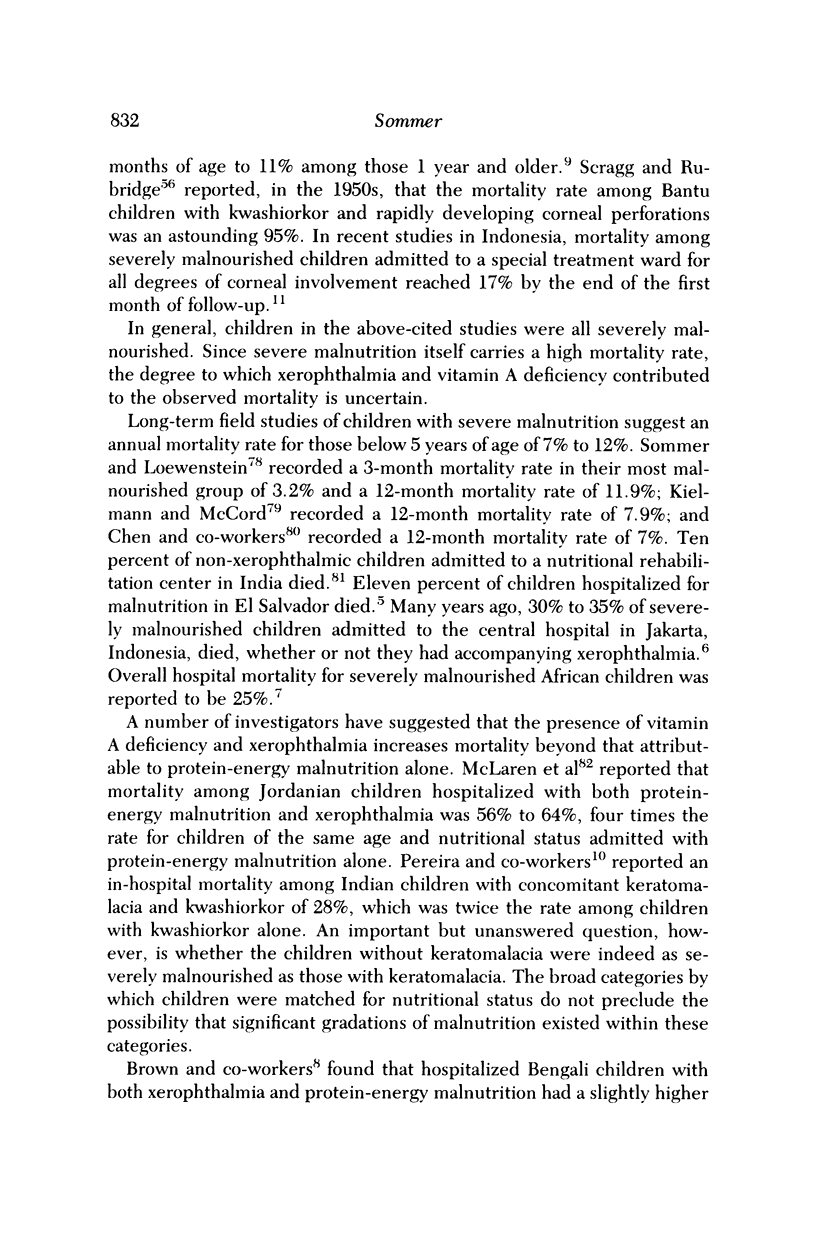
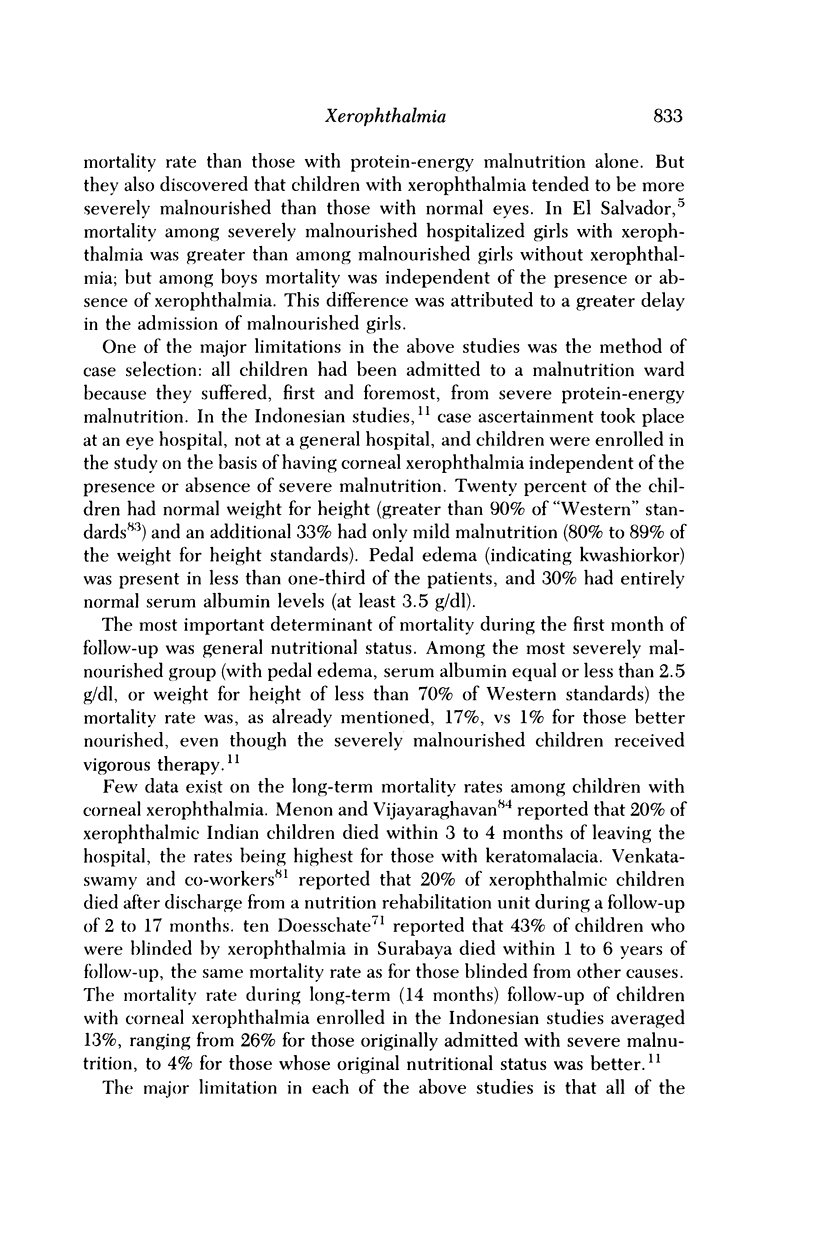
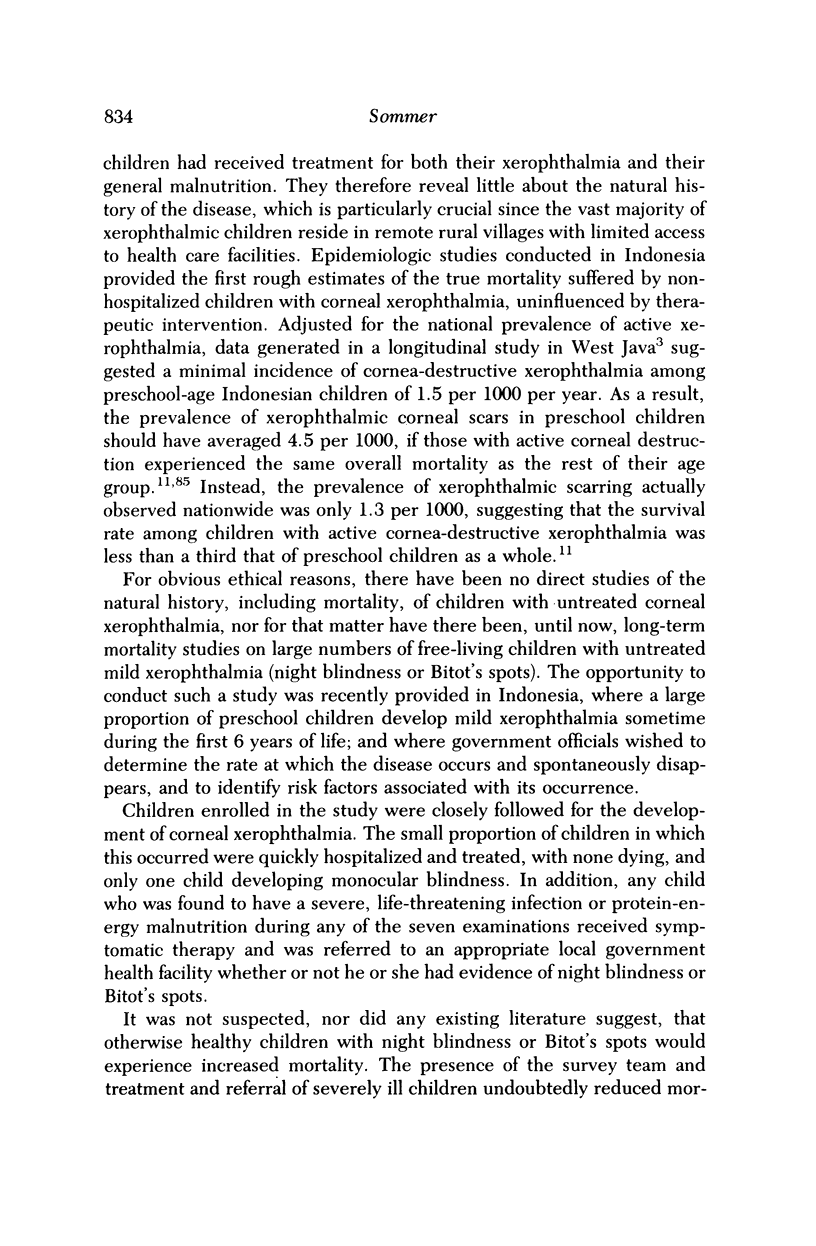
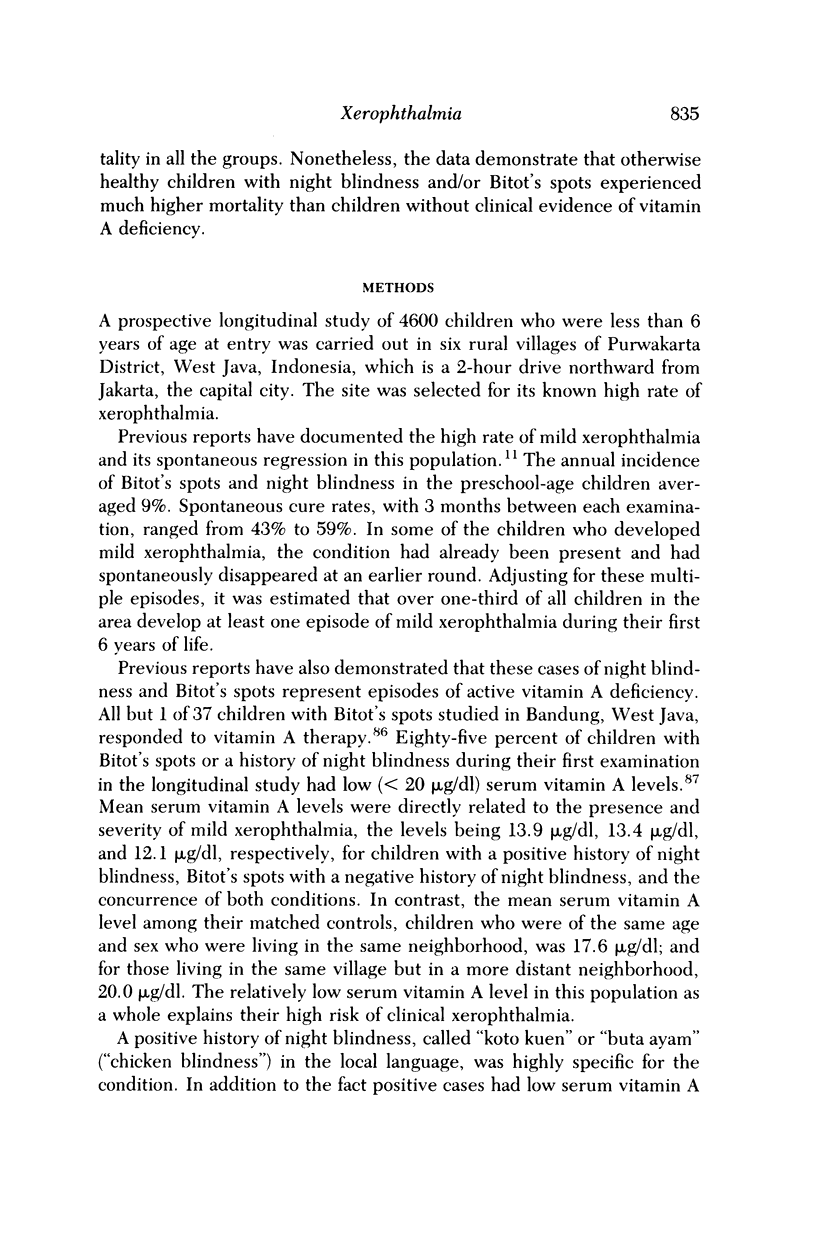
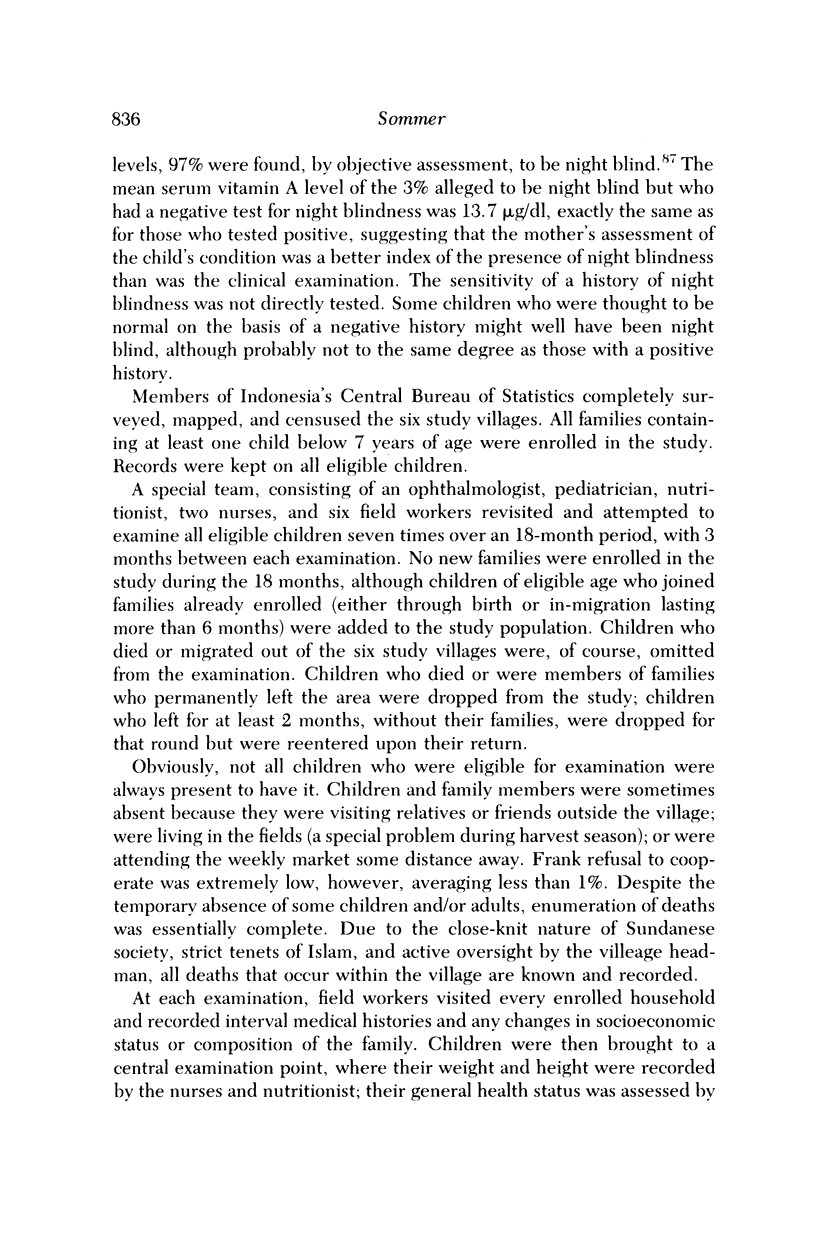
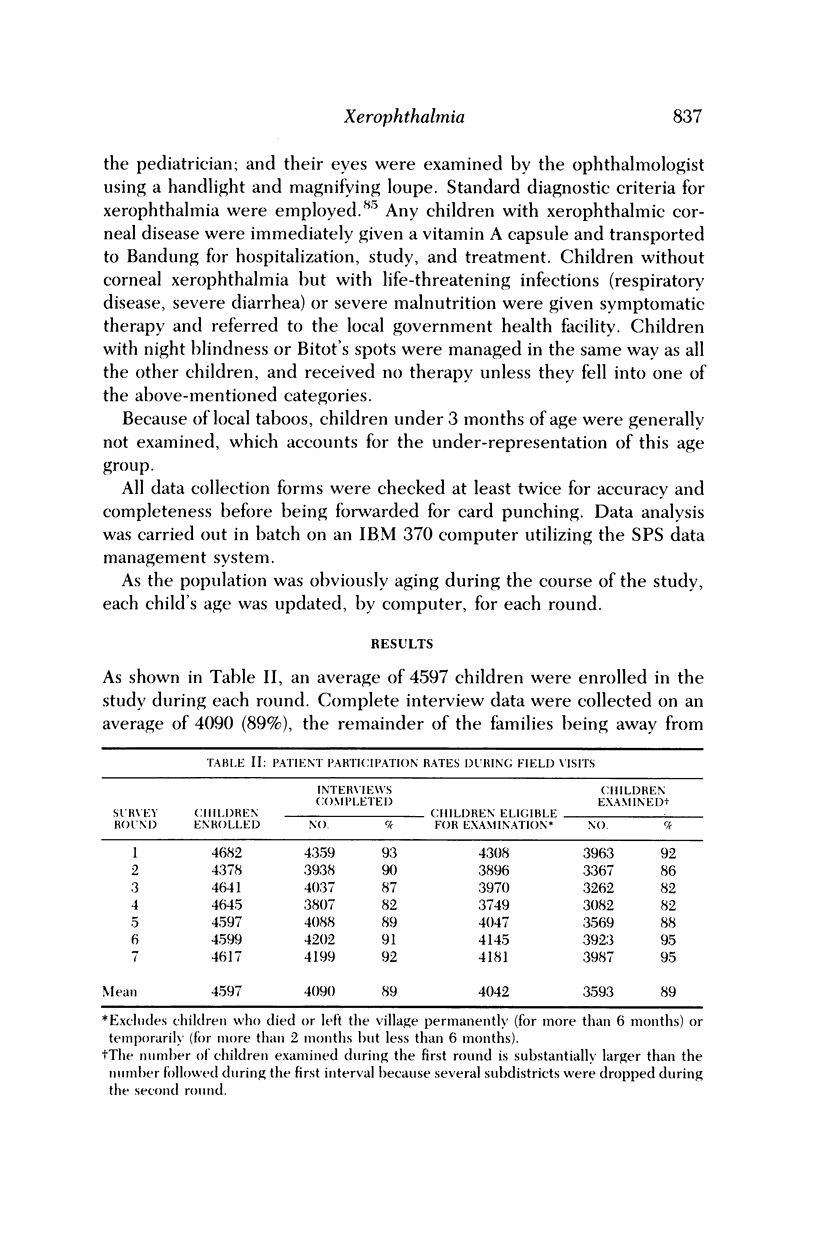
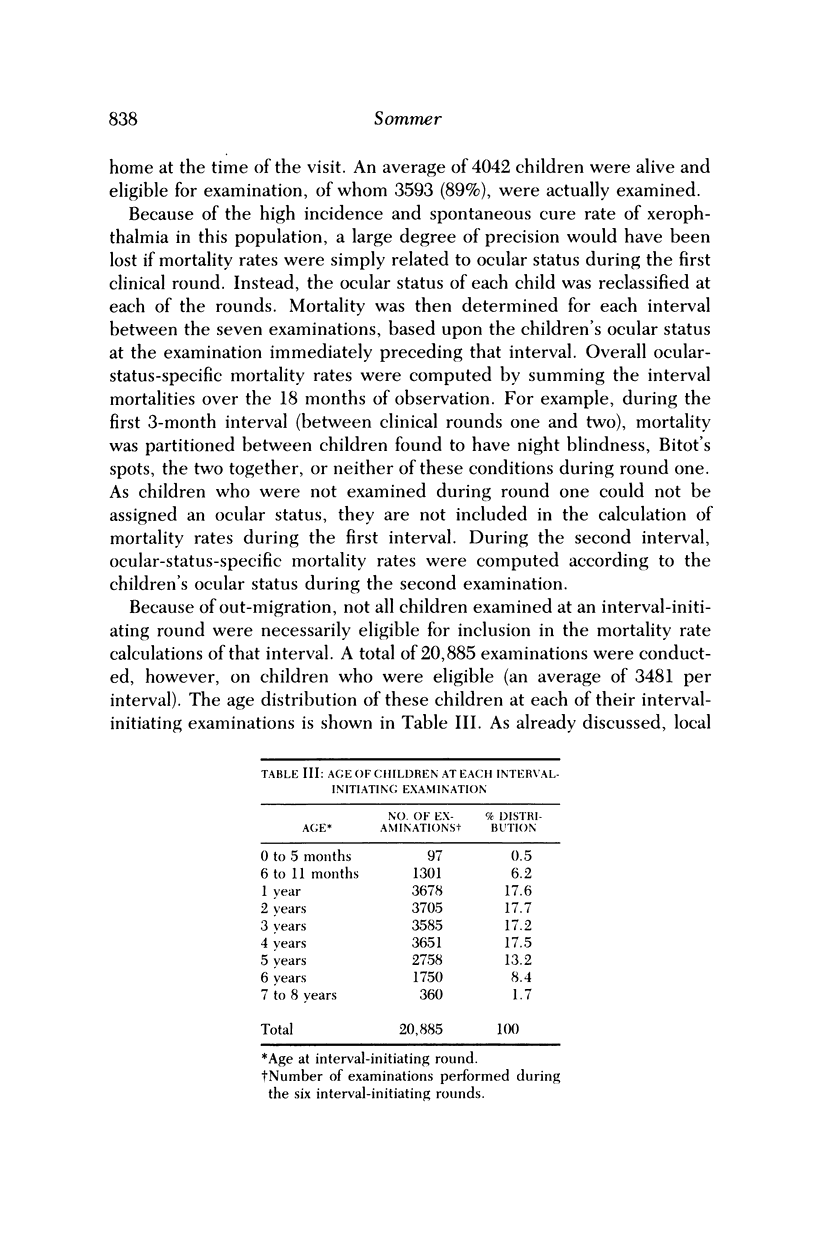
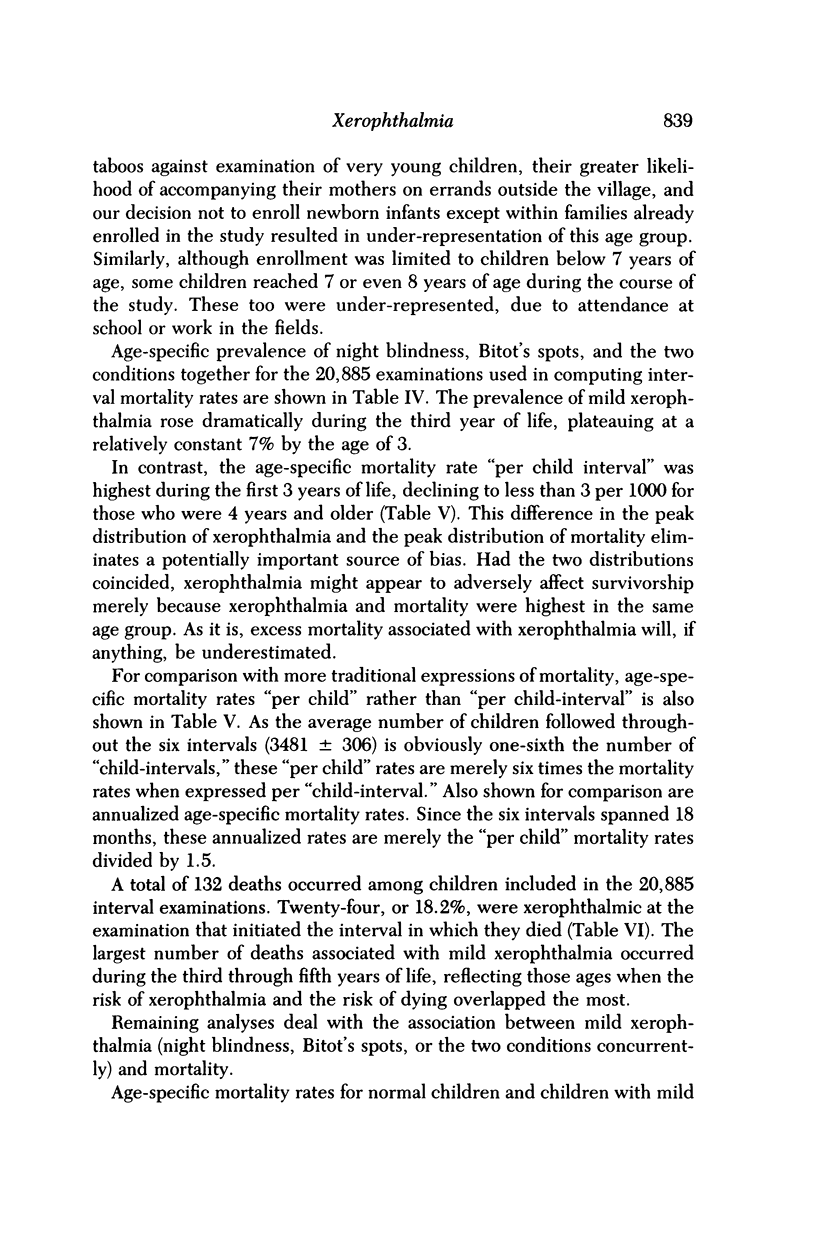
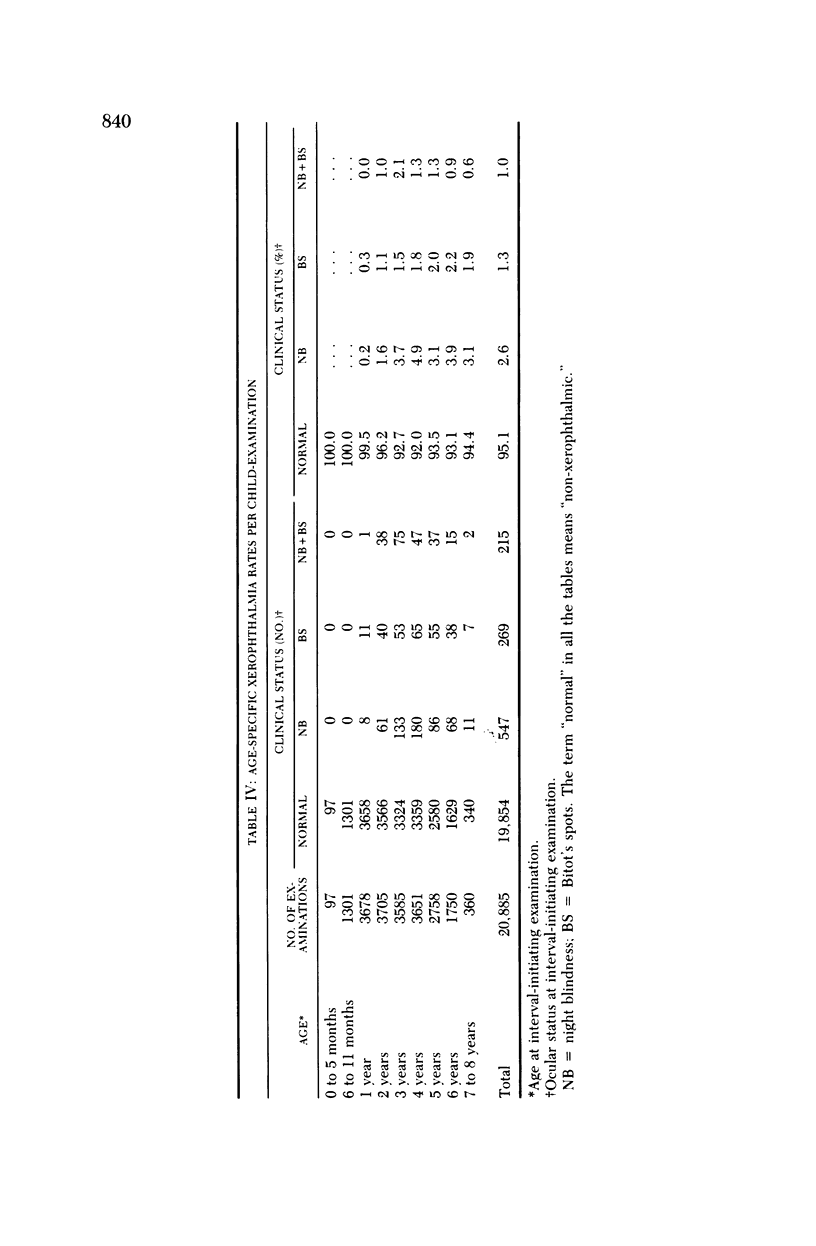
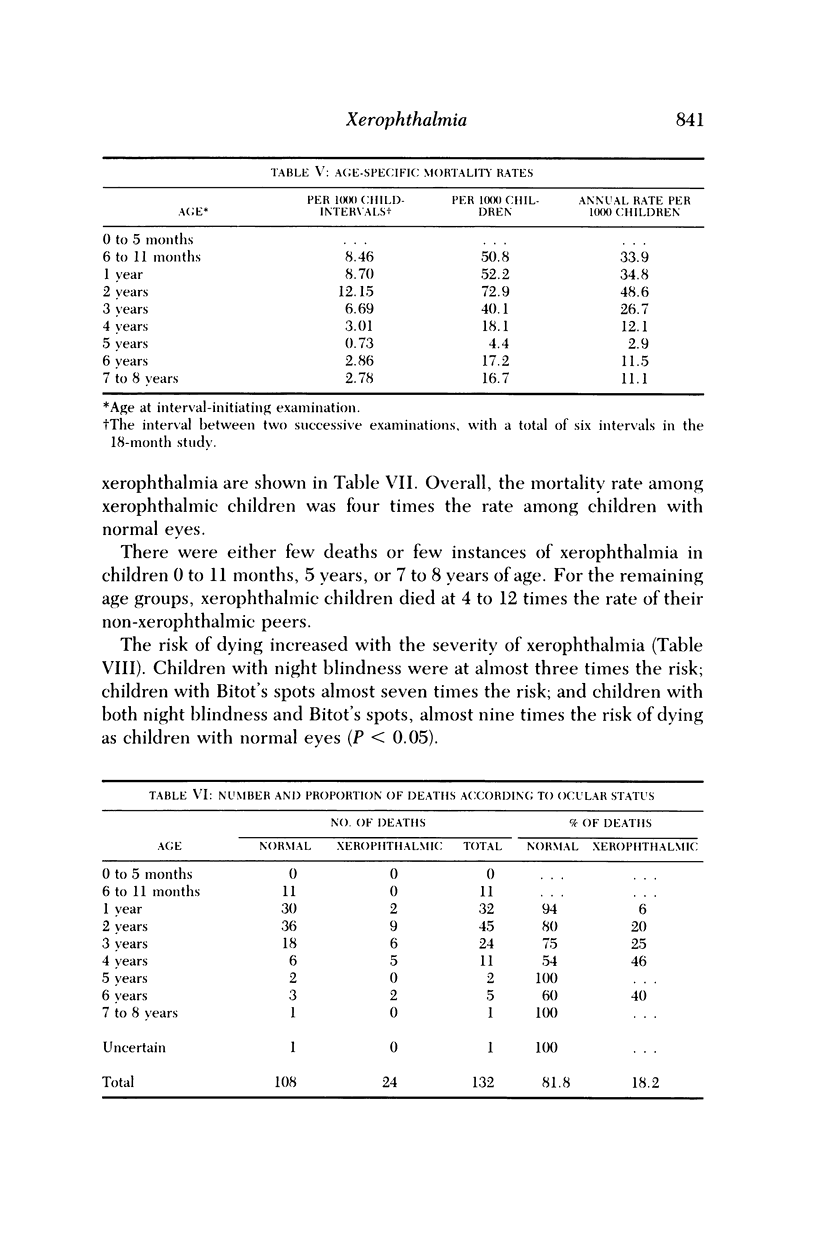
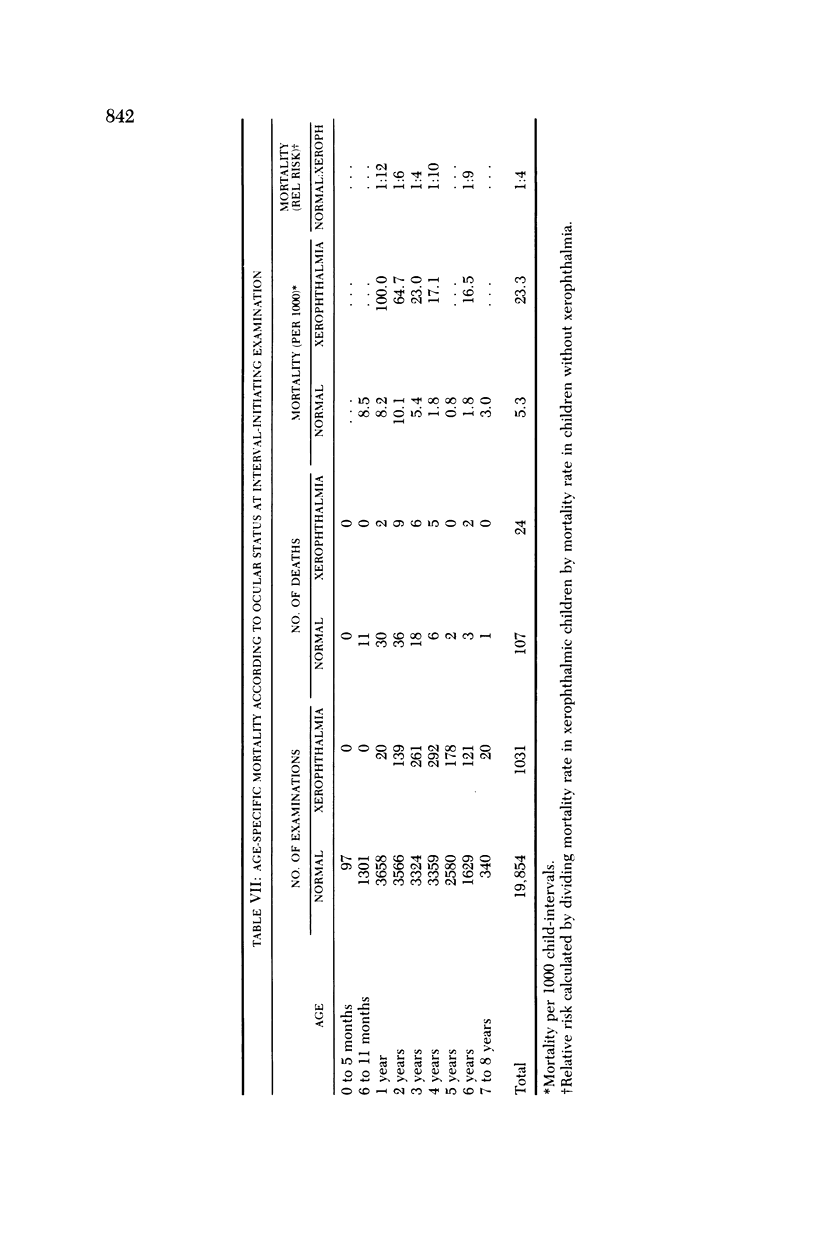
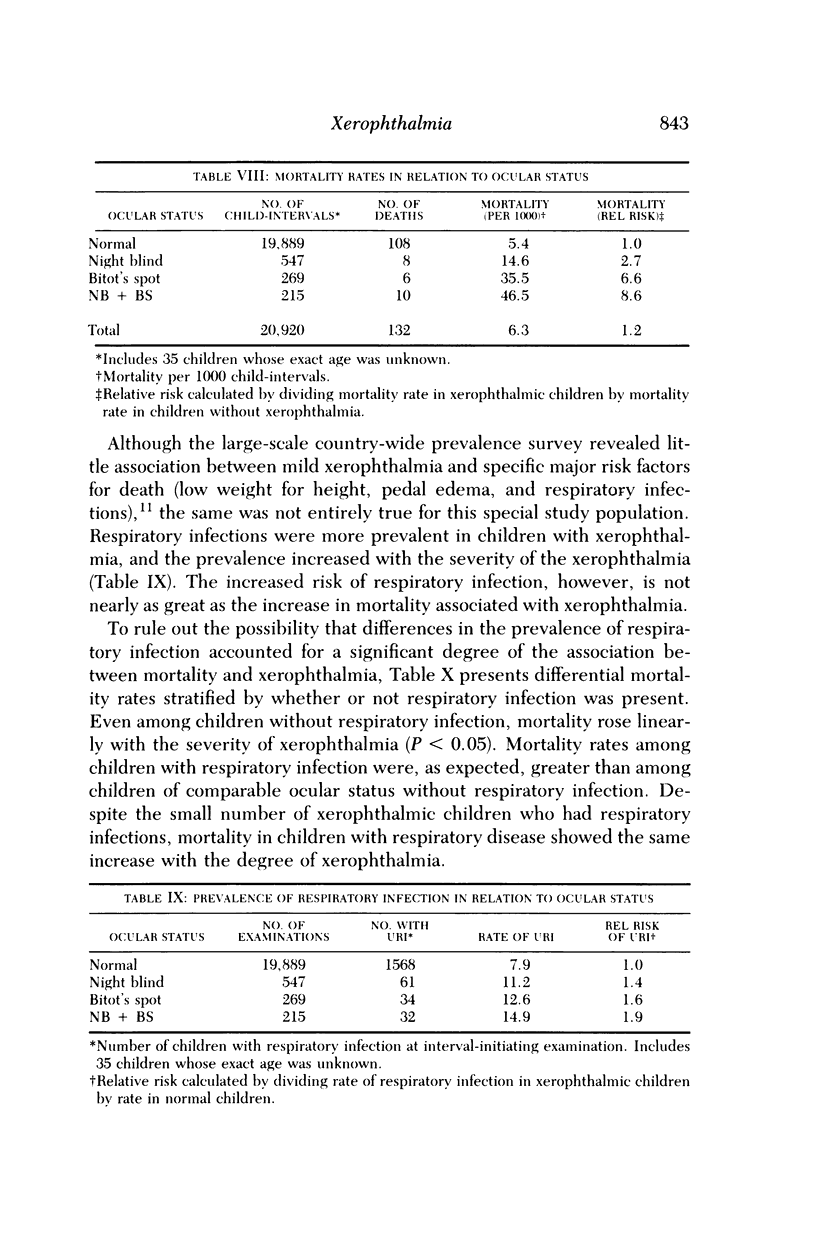
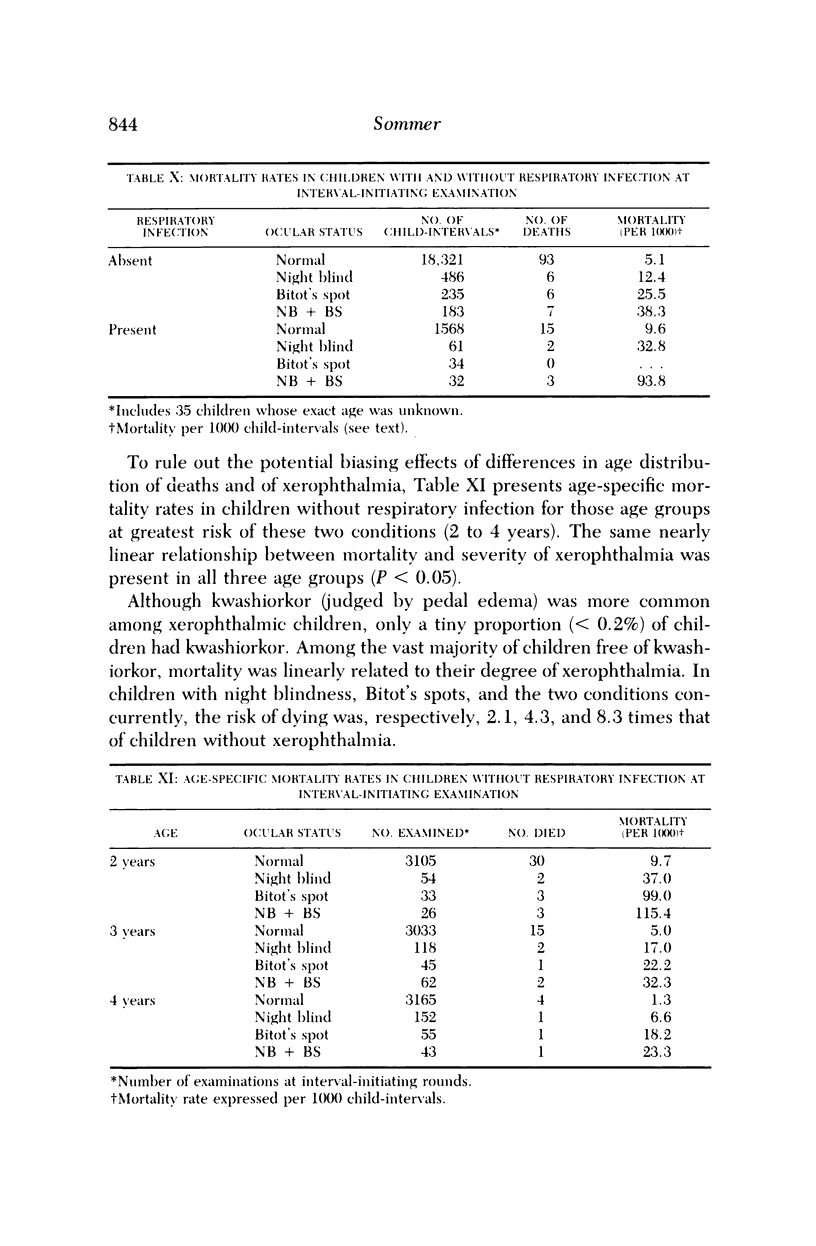
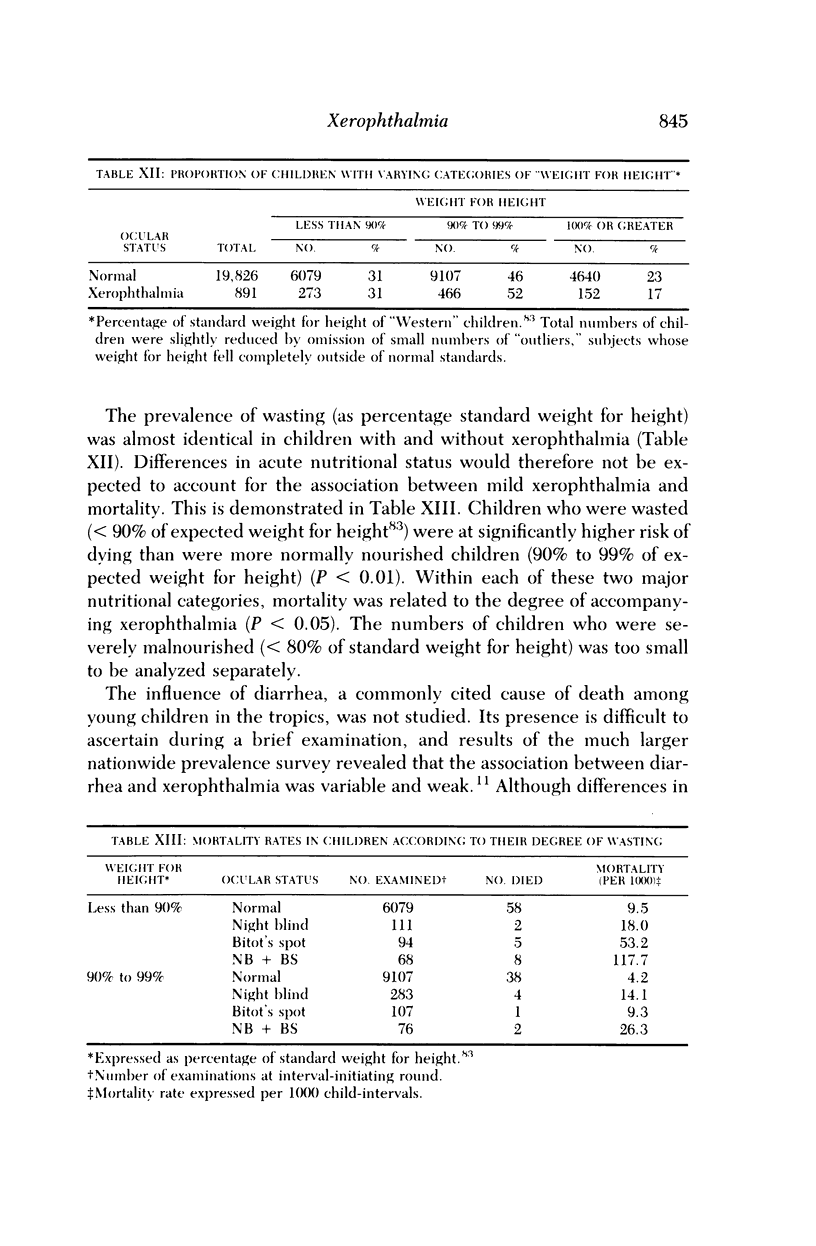
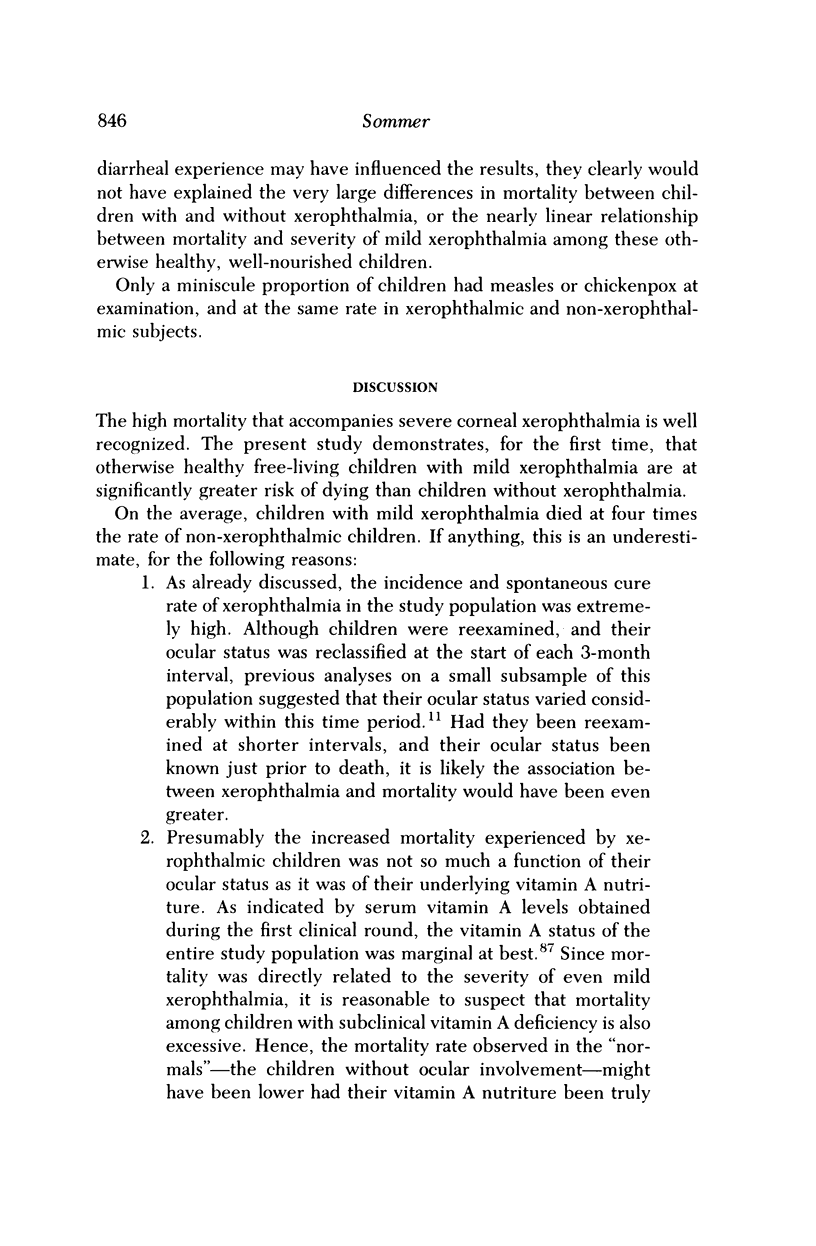
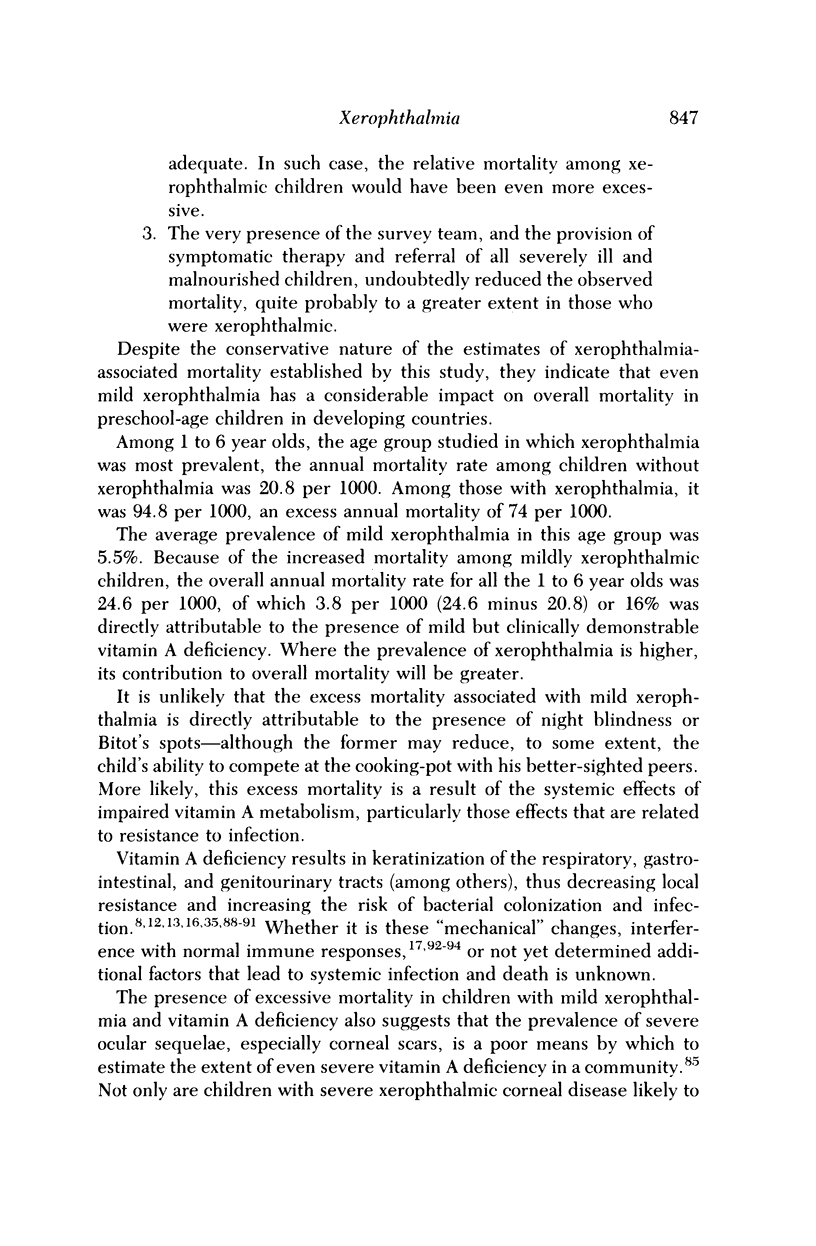
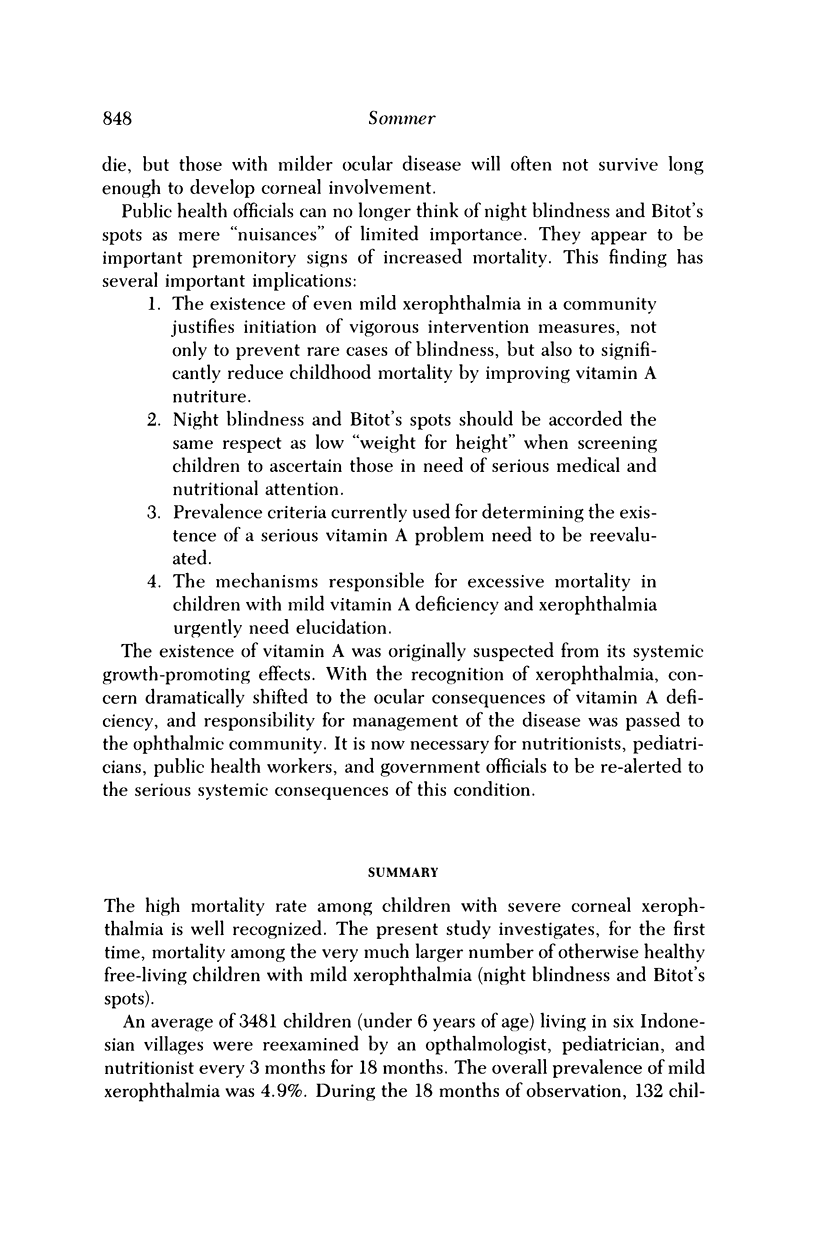
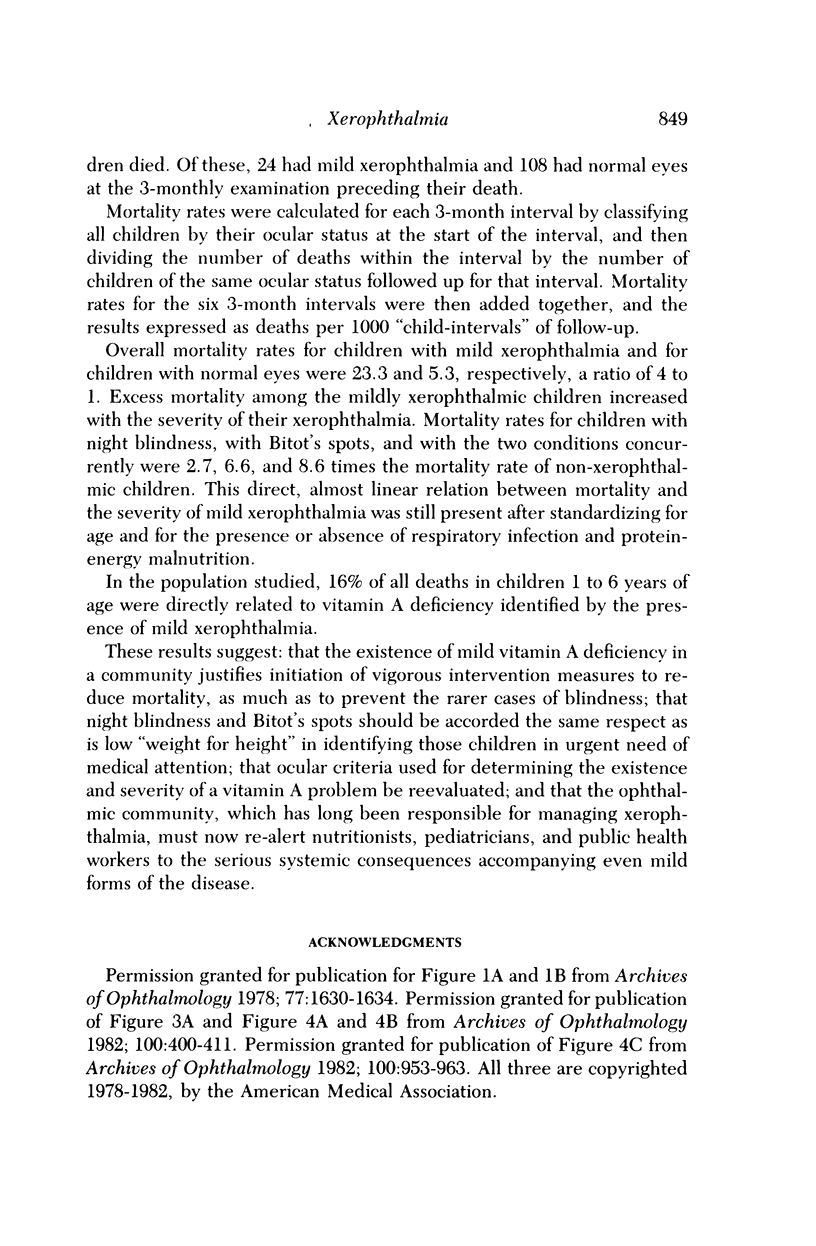
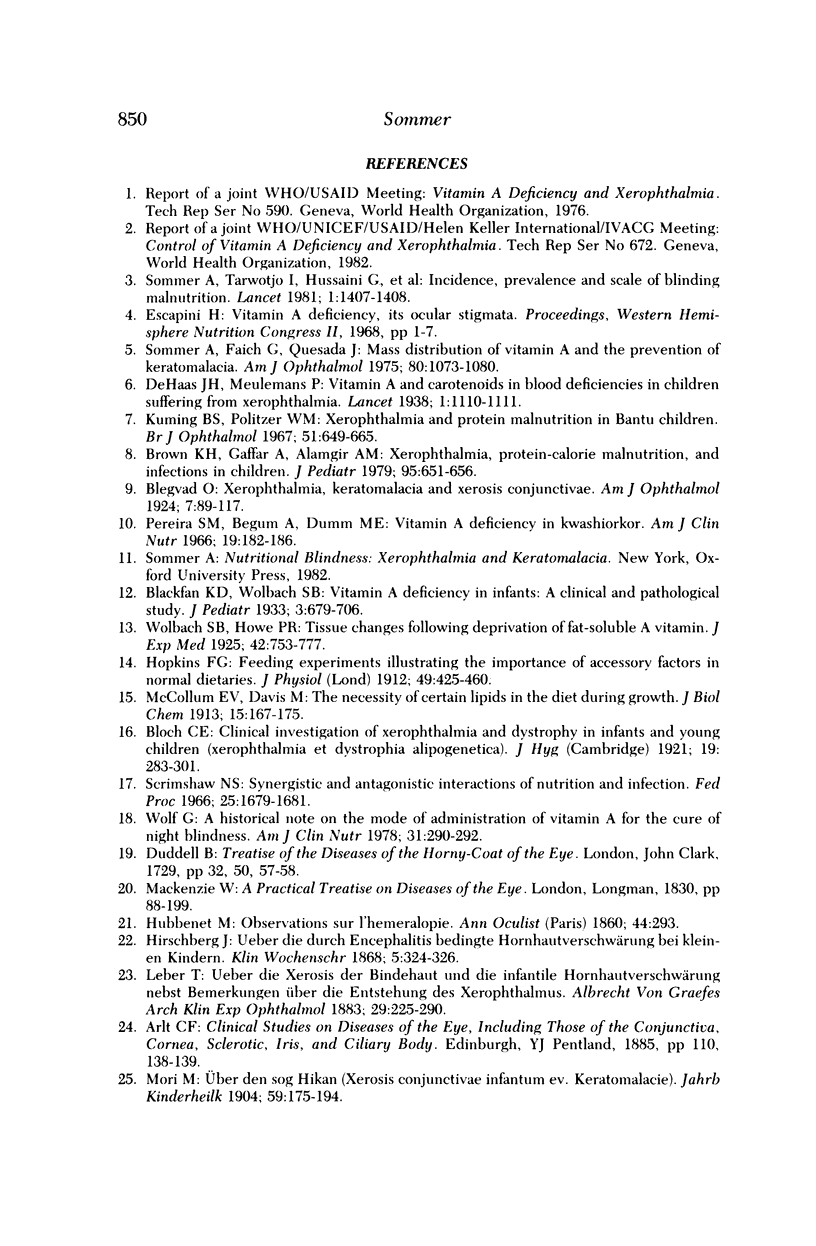
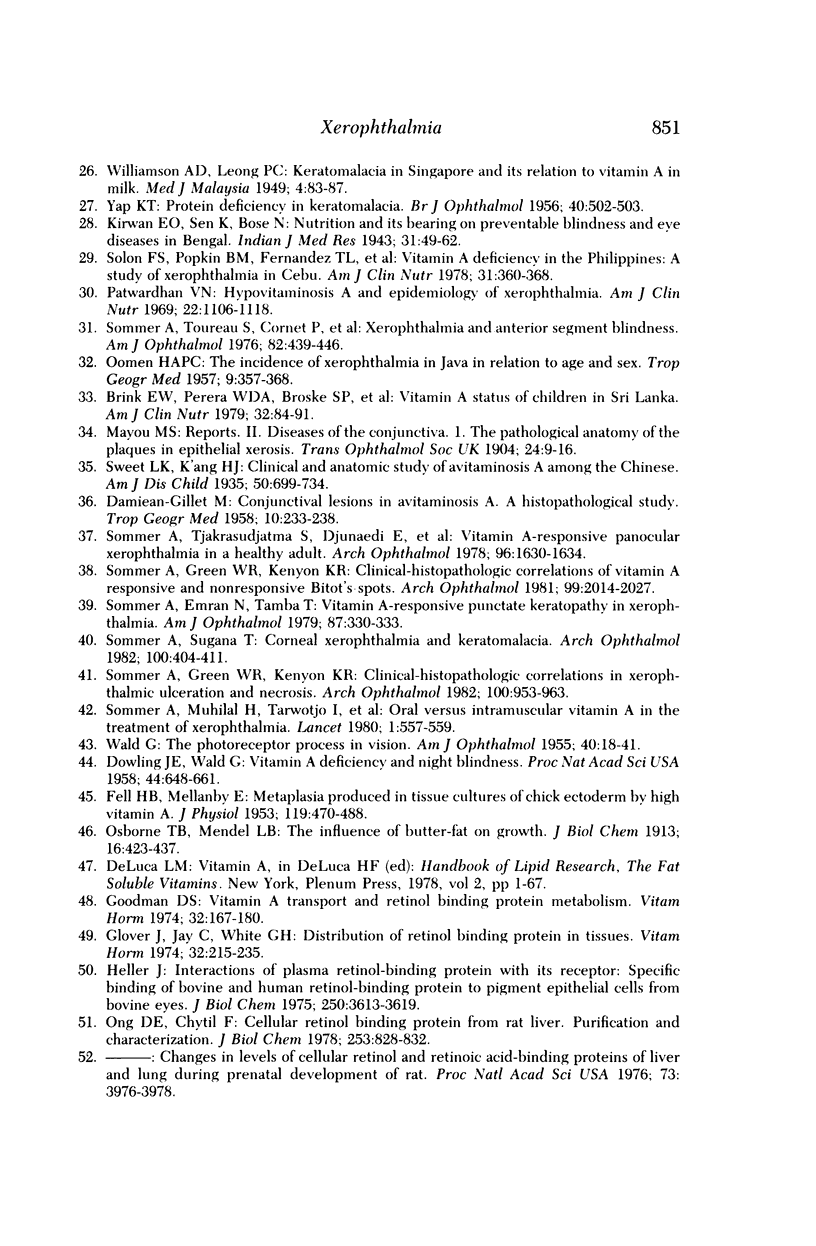
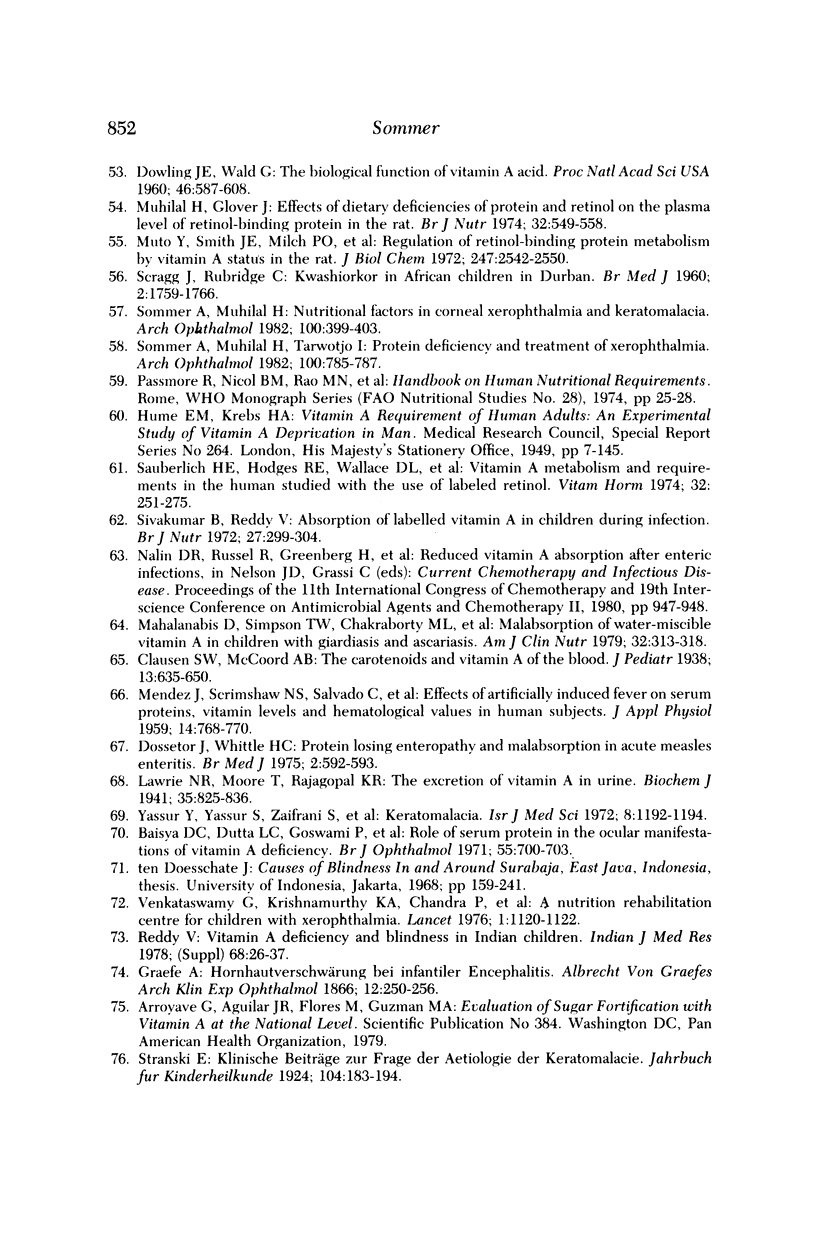
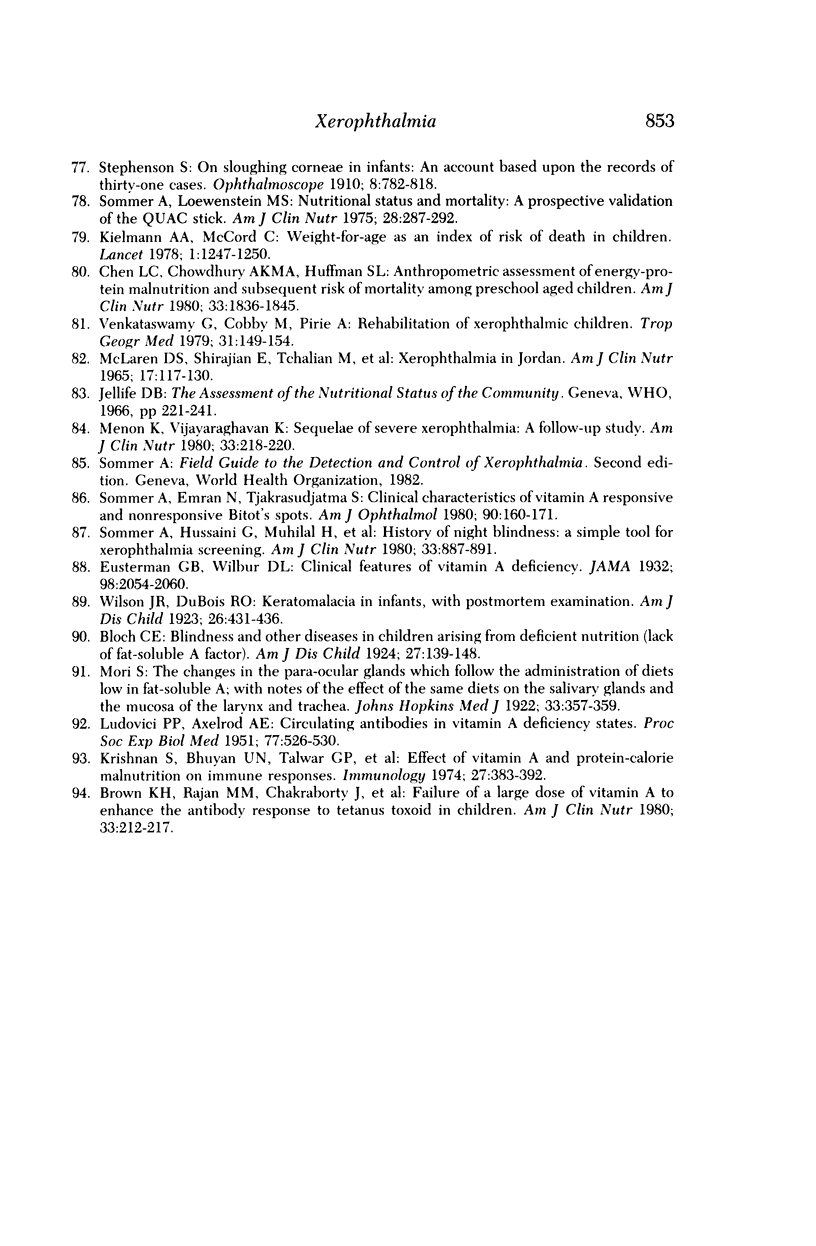
Images in this article
Selected References
These references are in PubMed. This may not be the complete list of references from this article.
- Baisya D. C., Dutta L. C., Goswami P., Saha S. K. Role of serum protein in the ocular manifestations of vitamin A deficiency. Br J Ophthalmol. 1971 Oct;55(10):700–703. doi: 10.1136/bjo.55.10.700. [DOI] [PMC free article] [PubMed] [Google Scholar]
- Brink E. W., Perera W. D., Broske S. P., Cash R. A., Smith J. L., Sauberlich H. E., Bashor M. M. Vitamin A status of children in Sri Lanka. Am J Clin Nutr. 1979 Jan;32(1):84–91. doi: 10.1093/ajcn/32.1.84. [DOI] [PubMed] [Google Scholar]
- Brown K. H., Gaffar A., Alamgir S. M. Xerophthalmia, protein-calorie malnutrition, and infections in children. J Pediatr. 1979 Oct;95(4):651–656. doi: 10.1016/s0022-3476(79)80790-8. [DOI] [PubMed] [Google Scholar]
- Brown K. H., Rajan M. M., Chakraborty J., Aziz K. M. Failure of a large dose of vitamin A to enhance the antibody response to tetanus toxoid in children. Am J Clin Nutr. 1980 Feb;33(2):212–217. doi: 10.1093/ajcn/33.2.212. [DOI] [PubMed] [Google Scholar]
- Chen L. C., Chowdhury A., Huffman S. L. Anthropometric assessment of energy-protein malnutrition and subsequent risk of mortality among preschool aged children. Am J Clin Nutr. 1980 Aug;33(8):1836–1845. doi: 10.1093/ajcn/33.8.1836. [DOI] [PubMed] [Google Scholar]
- DAMIEAN-GILLET M. Conjunctival lesions in avitaminosis A: a histopathological study. Trop Geogr Med. 1958 Sep;10(3):233–238. [PubMed] [Google Scholar]
- Dossetor J. F., Whittle H. C. Protein-losing enteropathy and malabsorption in acute measles enteritis. Br Med J. 1975 Jun 14;2(5971):592–593. doi: 10.1136/bmj.2.5971.592. [DOI] [PMC free article] [PubMed] [Google Scholar]
- Dowling J. E., Wald G. THE BIOLOGICAL FUNCTION OF VITAMIN A ACID. Proc Natl Acad Sci U S A. 1960 May;46(5):587–608. doi: 10.1073/pnas.46.5.587. [DOI] [PMC free article] [PubMed] [Google Scholar]
- Dowling J. E., Wald G. VITAMIN A DEFICIENCY AND NIGHT BLINDNESS. Proc Natl Acad Sci U S A. 1958 Jul 15;44(7):648–661. doi: 10.1073/pnas.44.7.648. [DOI] [PMC free article] [PubMed] [Google Scholar]
- Emran N., Tjakrasudjatma S. Clinical characteristics of vitamin A responsive and nonresponsive Bitot's spots. Am J Ophthalmol. 1980 Aug;90(2):160–171. doi: 10.1016/s0002-9394(14)74848-2. [DOI] [PubMed] [Google Scholar]
- FELL H. B., MELLANBY E. Metaplasia produced in cultures of chick ectoderm by high vitamin A. J Physiol. 1953 Mar;119(4):470–488. doi: 10.1113/jphysiol.1953.sp004860. [DOI] [PMC free article] [PubMed] [Google Scholar]
- Glover J., Jay C., White G. H. Distribution of retinol-binding protein in tissues. Vitam Horm. 1974;32:215–235. doi: 10.1016/s0083-6729(08)60013-8. [DOI] [PubMed] [Google Scholar]
- Goodman D. S. Vitamin A transport and retinol-binding protein metabolism. Vitam Horm. 1974;32:167–180. doi: 10.1016/s0083-6729(08)60011-4. [DOI] [PubMed] [Google Scholar]
- Heller J. Interactions of plasma retinol-binding protein with its receptor. Specific binding of bovine and human retinol-binding protein to pigment epithelium cells from bovine eyes. J Biol Chem. 1975 May 25;250(10):3613–3619. [PubMed] [Google Scholar]
- Hopkins F. G. Feeding experiments illustrating the importance of accessory factors in normal dietaries. J Physiol. 1912 Jul 15;44(5-6):425–460. doi: 10.1113/jphysiol.1912.sp001524. [DOI] [PMC free article] [PubMed] [Google Scholar]
- Kielmann A. A., McCord C. Weight-for-age as an index of risk of death in children. Lancet. 1978 Jun 10;1(8076):1247–1250. doi: 10.1016/s0140-6736(78)92478-9. [DOI] [PubMed] [Google Scholar]
- Krishnan S., Bhuyan U. N., Talwar G. P., Ramalingaswami V. Effect of vitamin A and protein-calorie undernutrition on immune responses. Immunology. 1974 Sep;27(3):383–392. [PMC free article] [PubMed] [Google Scholar]
- Kuming B. S., Politzer W. M. Xerophthalmia and protein malnutrition in Bantu children. Br J Ophthalmol. 1967 Oct;51(10):649–666. doi: 10.1136/bjo.51.10.649. [DOI] [PMC free article] [PubMed] [Google Scholar]
- LUDOVICI P. P., AXELROD A. E. Circulating antibodies in vitamin-deficiency states; pteroylglutamic acid, niacin-tryptophan, vitamins B12, A, and D deficiencies. Proc Soc Exp Biol Med. 1951 Jul;77(3):526–530. doi: 10.3181/00379727-77-18836. [DOI] [PubMed] [Google Scholar]
- Lawrie N. R., Moore T., Rajagopal K. R. The excretion of vitamin A in urine. Biochem J. 1941 Jul;35(7):825–836. doi: 10.1042/bj0350825. [DOI] [PMC free article] [PubMed] [Google Scholar]
- Mahalanabis D., Simpson T. W., Chakraborty M. L., Ganguli C., Bhattacharjee A. K., Mukherjee K. L. Malabsorption of water miscible vitamin A in children with giardiasis and ascariasis. Am J Clin Nutr. 1979 Feb;32(2):313–318. doi: 10.1093/ajcn/32.2.313. [DOI] [PubMed] [Google Scholar]
- McLaren D. S., Shirajian E., Tchalian M., Khoury G. Xerophthalmia in Jordan. Am J Clin Nutr. 1965 Sep;17(3):117–130. doi: 10.1093/ajcn/17.3.117. [DOI] [PubMed] [Google Scholar]
- Menon K., Vijayaraghavan K. Sequelae of severe xerophthalmia--a follow-up study. Am J Clin Nutr. 1980 Feb;33(2):218–220. doi: 10.1093/ajcn/33.2.218. [DOI] [PubMed] [Google Scholar]
- Muhilal H., Glover J. Effects of dietary deficiencies of protein and retinol on the plasma level of retinol-binding protein in the rat. Br J Nutr. 1974 Nov;32(3):549–558. doi: 10.1079/bjn19740108. [DOI] [PubMed] [Google Scholar]
- Muto Y., Smith J. E., Milch P. O., Goodman D. S. Regulation of retinol-binding protein metabolism by vitamin A status in the rat. J Biol Chem. 1972 Apr 25;247(8):2542–2550. [PubMed] [Google Scholar]
- OOMEN H. A. The incidence of xerophthalmia in Java in relation to age and sex. Doc Med Geogr Trop. 1957 Dec;9(4):357–368. [PubMed] [Google Scholar]
- Ong D. E., Chytil F. Cellular retinol-binding protein from rat liver. Purification and characterization. J Biol Chem. 1978 Feb 10;253(3):828–832. [PubMed] [Google Scholar]
- Patwardhan V. N. Hypovitaminosis A and epidemiology of xerophthalmia. Am J Clin Nutr. 1969 Aug;22(8):1106–1118. doi: 10.1093/ajcn/22.8.1106. [DOI] [PubMed] [Google Scholar]
- Pereira S. M., Begum A., Dumm M. E. Vitamin A deficiency in kwashiorkor. Am J Clin Nutr. 1966 Sep;19(3):182–186. doi: 10.1093/ajcn/19.3.182. [DOI] [PubMed] [Google Scholar]
- Reddy V. Vitamin A deficiency and blindness in Indian children. Indian J Med Res. 1978 Oct;68 (Suppl):26–37. [PubMed] [Google Scholar]
- SCRAGG J., RUBIDGE C. Kwashiorkor in African children in Durban. Br Med J. 1960 Dec 17;2(5215):1759–1766. doi: 10.1136/bmj.2.5215.1759. [DOI] [PMC free article] [PubMed] [Google Scholar]
- Sauberlich H. E., Hodges R. E., Wallace D. L., Kolder H., Canham J. E., Hood J., Raica N., Jr, LOWRY L. K. Vitamin A metabolism and requirements in the human studied with the use of labeled retinol. Vitam Horm. 1974;32:251–275. doi: 10.1016/s0083-6729(08)60015-1. [DOI] [PubMed] [Google Scholar]
- Scrimshaw N. S. Synergistic and antagonistic interactions of nutrition and infection. Fed Proc. 1966 Nov-Dec;25(6):1679–1681. [PubMed] [Google Scholar]
- Sivakumar B., Reddy V. Absorption of labelled vitamin A in children during infection. Br J Nutr. 1972 Mar;27(2):299–304. doi: 10.1079/bjn19720094. [DOI] [PubMed] [Google Scholar]
- Solon F. S., Popkin B. M., Fernandez T. L., Latham M. C. Vitamin A deficiency in the Philippines: a study of xerophthalmia in Cebu. Am J Clin Nutr. 1978 Feb;31(2):360–368. doi: 10.1093/ajcn/31.2.360. [DOI] [PubMed] [Google Scholar]
- Sommer A., Emran N., Tamba T. Vitamin A-responsive punctate keratopathy in xerophthalmia. Am J Ophthalmol. 1979 Mar;87(3):330–333. doi: 10.1016/0002-9394(79)90072-2. [DOI] [PubMed] [Google Scholar]
- Sommer A., Faich G., Quesada J. Mass distribution of vitamin A and the prevention of keratomalacia. Am J Ophthalmol. 1975 Dec;80(6):1073–1080. doi: 10.1016/0002-9394(75)90338-4. [DOI] [PubMed] [Google Scholar]
- Sommer A., Green W. R., Kenyon K. R. Bitot's spots responsive and nonresponsive to vitamin A. Clinicopathologic correlations. Arch Ophthalmol. 1981 Nov;99(11):2014–2027. doi: 10.1001/archopht.1981.03930020890016. [DOI] [PubMed] [Google Scholar]
- Sommer A., Green W. R., Kenyon K. R. Clinicohistopathologic correlations in xerophthalmic ulceration and necrosis. Arch Ophthalmol. 1982 Jun;100(6):953–963. doi: 10.1001/archopht.1982.01030030961014. [DOI] [PubMed] [Google Scholar]
- Sommer A., Hussaini G., Muhilal, Tarwotjo I., Susanto D., Saroso J. S. History of nightblindness: a simple tool for xerophthalmia screening. Am J Clin Nutr. 1980 Apr;33(4):887–891. doi: 10.1093/ajcn/33.4.887. [DOI] [PubMed] [Google Scholar]
- Sommer A., Loewenstein M. S. Nutritional status and mortality: a prospective validation of the QUAC stick. Am J Clin Nutr. 1975 Mar;28(3):287–292. doi: 10.1093/ajcn/28.3.287. [DOI] [PubMed] [Google Scholar]
- Sommer A., Muhilal, Tarwotjo I., Djunaedi E., Glover J. Oral versus intramuscular vitamin A in the treatment of xerophthalmia. Lancet. 1980 Mar 15;1(8168 Pt 1):557–559. doi: 10.1016/s0140-6736(80)91053-3. [DOI] [PubMed] [Google Scholar]
- Sommer A. Nutritional factors in corneal xerophthalmia and keratomalacia. Arch Ophthalmol. 1982 Mar;100(3):399–403. doi: 10.1001/archopht.1982.01030030401002. [DOI] [PubMed] [Google Scholar]
- Sommer A., Sugana T. Corneal xerophthalmia and keratomalacia. Arch Ophthalmol. 1982 Mar;100(3):404–411. doi: 10.1001/archopht.1982.01030030406003. [DOI] [PubMed] [Google Scholar]
- Sommer A., Tarwotjo I., Hussaini G., Susanto D., Soegiharto T. Incidence, prevalence, and scale of blinding malnutrition. Lancet. 1981 Jun 27;1(8235):1407–1408. doi: 10.1016/s0140-6736(81)92581-2. [DOI] [PubMed] [Google Scholar]
- Sommer A., Tarwotjo I. Protein deficiency and treatment of xerophthalmia. Arch Ophthalmol. 1982 May;100(5):785–787. doi: 10.1001/archopht.1982.01030030789012. [DOI] [PubMed] [Google Scholar]
- Sommer A., Tjakrasudjatma S., Djunaedi E., Green W. R. Vitamin A-responsive panocular xerophthalmia in a healthy adult. Arch Ophthalmol. 1978 Sep;96(9):1630–1634. doi: 10.1001/archopht.1978.03910060264016. [DOI] [PubMed] [Google Scholar]
- Sommer A., Toureau S., Cornet P., Midy C., Pettiss S. T. Xerophthalmia and anterior segment blindness. Am J Ophthalmol. 1976 Sep;82(3):439–446. doi: 10.1016/0002-9394(76)90492-x. [DOI] [PubMed] [Google Scholar]
- Venkataswamy G., Cobby M., Pirie A. Rehabilitation of xeropthalmic children. A follow-up study in southern India. Trop Geogr Med. 1979 Mar;31(1):149–154. [PubMed] [Google Scholar]
- Venkataswamy G., Krishnamurthy K. A., Chandra P., Kabir S. A., Pirie A. A nutrition rehabilitation centre for children with xerophthalmia. Lancet. 1976 May 22;1(7969):1120–1122. doi: 10.1016/s0140-6736(76)99001-2. [DOI] [PubMed] [Google Scholar]
- WALD G. The photoreceptor process in vision. Am J Ophthalmol. 1955 Nov;40(5 Pt 2):18–41. doi: 10.1016/0002-9394(55)91835-3. [DOI] [PubMed] [Google Scholar]
- Wolf G. A historical note on the mode of administration of vitamin A for the cure of night blindness. Am J Clin Nutr. 1978 Feb;31(2):290–292. doi: 10.1093/ajcn/31.2.290. [DOI] [PubMed] [Google Scholar]
- YAP-KIE-TIONG Protein deficiency in keratomalacia. Br J Ophthalmol. 1956 Aug;40(8):502–503. doi: 10.1136/bjo.40.8.502. [DOI] [PMC free article] [PubMed] [Google Scholar]
- Yassur Y., Yassur S., Zaifrani S., Zachs U., Ben-Sira I. Clinical aspects of keratomalacia. Isr J Med Sci. 1972 Aug-Sep;8(8):1192–1194. [PubMed] [Google Scholar]









